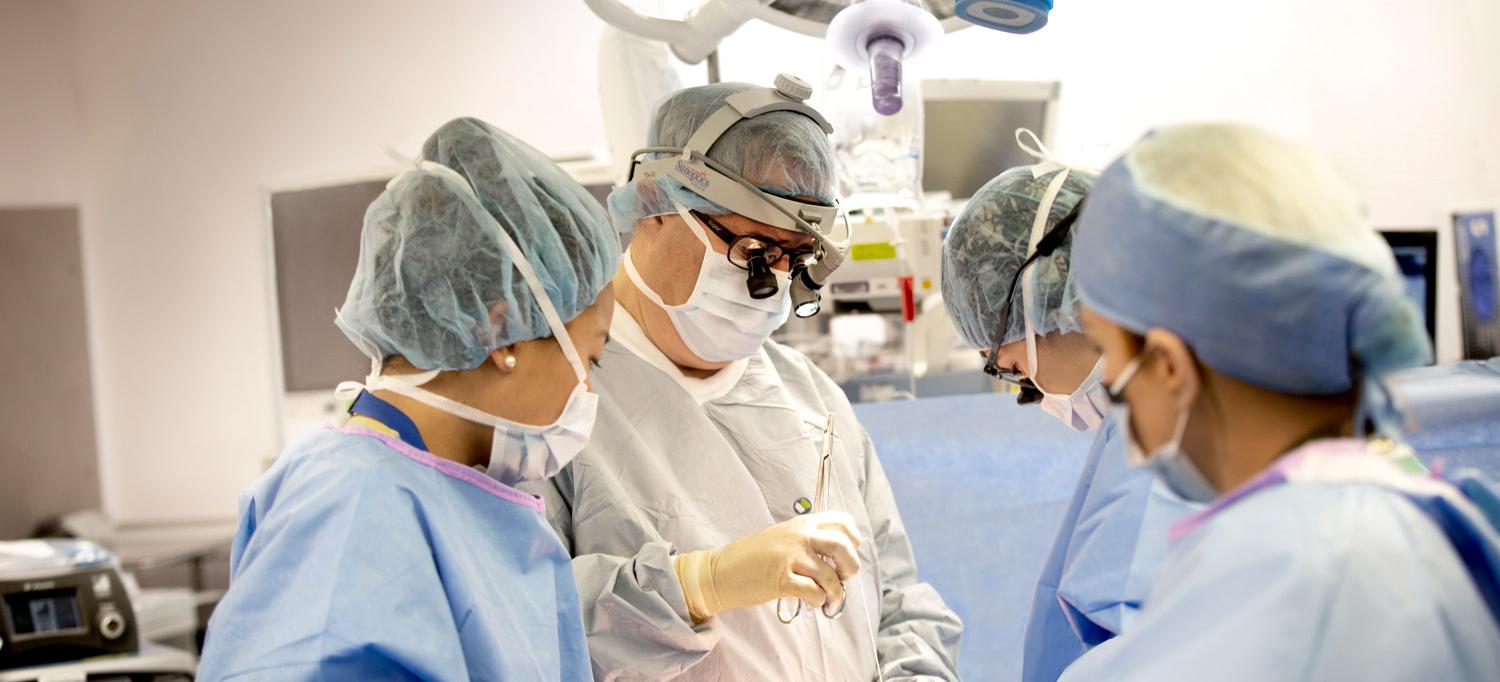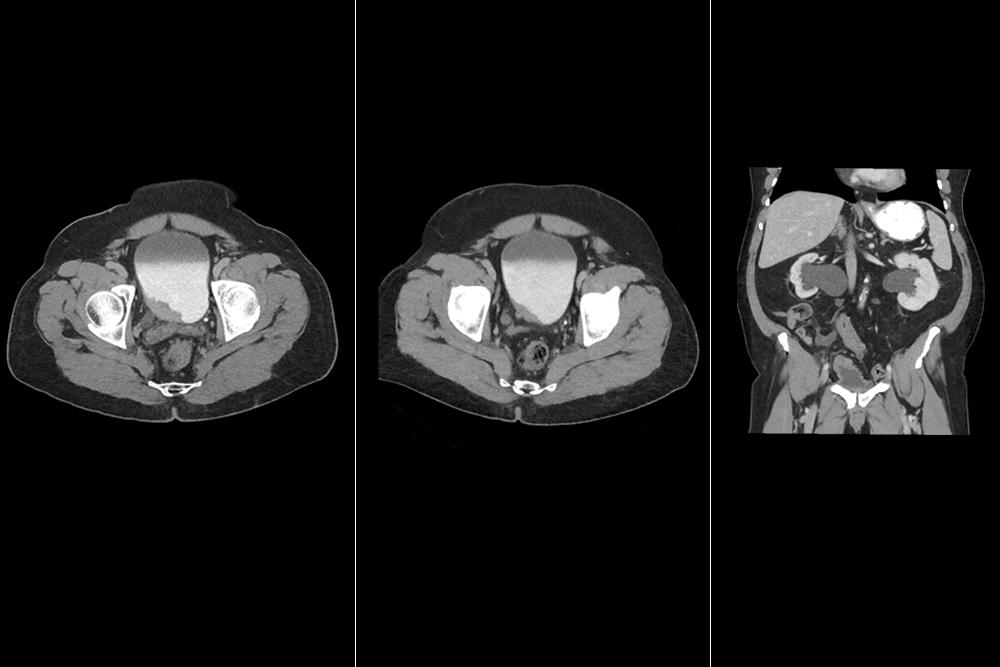
Bladder cancer surgeon Dr. Gary D. Steinberg has extensive experience in creating an orthotopic neobladder following an open radical cystectomy.
Photo: NYU Langone Staff
A 59-year-old, married, white male with a history of obesity, chronic obstructive pulmonary disease (COPD) related to ongoing tobacco smoking, and hypertension was presented for evaluation and referral to NYU Langone. The patient sought a consultation with Arjun V. Balar, MD, associate professor in the Division of Hematology and Medical Oncology within the Department of Medicine and director of the genitourinary medical oncology program at Perlmutter Cancer Center at NYU Langone.
Patient Presents with Muscle-Invasive Bladder Cancer
The patient had been newly diagnosed with muscle-invasive urothelial bladder cancer (MIBC), a highly mutated tumor. The patient’s primary risk factor was a long history of smoking. He had no family history of cancer.
Gross hematuria in September of 2018 had prompted an evaluation at an outside institution. Cystoscopy and CT urogram identified significant right-sided hydroureteronephrosis and possible T3 clinical disease, characterized by extension beyond muscle into the perivesical fat. In early October, the patient underwent transurethral resection of the bladder tumor, the initial step in staging evaluation, which revealed MIBC. The preferred treatment is radical cystectomy with resection of the bladder, regional lymph nodes, and adjacent organs.
Dr. Balar presented an option for a clinical trial evaluating neoadjuvant cisplatin-based chemotherapy with immunotherapy before radical cystectomy, which has been shown to improve survival for patients with MIBC.
Lead-in treatment began in mid-November 2018 with initiation of the first of four cycles of gemcitabine/cisplatin/atezolizumab. The patient completed the cycles in early February 2019, followed in early March by a final dose of the immunotherapeutic agent atezolizumab. Imaging after neoadjuvant therapy revealed prominent hilar lymph nodes, which were anthracotic (carbonaceous) on biopsy.
Surgeon Creates Neobladder to Allow for Urinary Diversion
A month after completing neoadjuvant combined therapy, the patient saw Gary D. Steinberg, MD, in consultation for radical cystectomy and orthotopic continent urinary tract reconstruction. A highly experienced bladder cancer surgeon, advocate, and researcher, Dr. Steinberg, professor in NYU Langone’s Department of Urology, director of the Goldstein Urology Bladder Cancer Program, and a member of Perlmutter Cancer Center, has developed expertise in continent urinary tract reconstruction with creation of a neobladder. The procedure allows the patient to live without an ileal conduit, which collects urine in an external bag through a stoma.
The surgery was uneventful. The surgeons did not discover any tumor outside the bladder, and the lymph nodes appeared grossly unremarkable. Surgeons preserved both of the patient’s neurovascular bundles for restoration of erectile function after surgery.
Postoperative findings were significant for high-grade urothelial carcinoma with 3 of 19 nodes positive. Specifically, the cancer was pathologically staged as pT2N2, or tumor invasion into the muscularis propria, with multiple regional lymph node metastasis in the true pelvis. Recovery after surgery was uncomplicated, and the ureteral stents were removed on postoperative day 7, with discharge home.
Next-Generation Tumor Sequencing Expands Options
With extensive experience in immunotherapies for bladder cancer, Dr. Steinberg hopes that personalizing treatment will optimize patient care, particularly in cases where the cancer has not responded adequately to initial treatments. In this case, the patient was referred to Dr. Balar for next-generation tumor sequencing and consideration of targeted adjuvant therapy.
On postoperative day 21, the patient’s Foley catheter and suprapubic tube were removed, and by 3 months after surgery, he was continent day and night and successfully using sildenafil to achieve erection. NYU Langone doctors are following the patient with surveillance imaging and reviewing his next-generation sequencing of the surgically resected tumor and lymph nodes.
Generally, checkpoint inhibitor immunotherapy targeting the protein programmed cell death 1 (PD-1) or its ligand (PD-L1) is recommended for patients who progress after platinum-based chemotherapy. In this patient, the checkpoint inhibitor atezolizumab was initially used in the combination neoadjuvant regimen. New therapies target tumor-specific genetic alterations and include recently approved erdafitinib for patients with advanced fibroblast growth factor receptor (FGFR)–mutated urothelial tumors.
In phase II trials, there was a response rate of almost 60 percent for chemotherapy plus immunotherapy in patients who had progression of the disease. Other potential targets include deletions in phosphatase and tensin homolog (PTEN), cyclin 1, and mouse double minute 2 homolog (MDM2); regulators of the G1–S cell cycle progression; aberrant chromatin remodeling genes; and cell adhesion molecule nectin-4.
Researchers at NYU Langone continue to collaborate in developing and evaluating novel agents for targeted personalized therapy, including through bladder cancer clinical trials.
Disclosures: Gary D. Steinberg, MD, is a member of clinical trial protocol committees for Merck, Bristol-Myers Squibb, Janssen, and Cold Genesys. He is a scientific advisor or consultant for Heat Biologics, Cold Genesys, Photocure, Merck, Roche/Genentech, Ciclomed, TARIS Biomedical, MDxHealth, Fidia Farmaceuticals, UroGen Pharma, Ferring Pharmaceuticals, Aduro Biotec, Boston Scientific, Bristol-Myers Squibb, AstraZeneca, Pfizer, Janssen, EpiVax Oncology, Natera, FKD Therapies Oy, EnGene Bio, and Sesen Bio. Dr. Steinberg has equity or stock options in EpiVax Oncology and UroGen Pharma.


